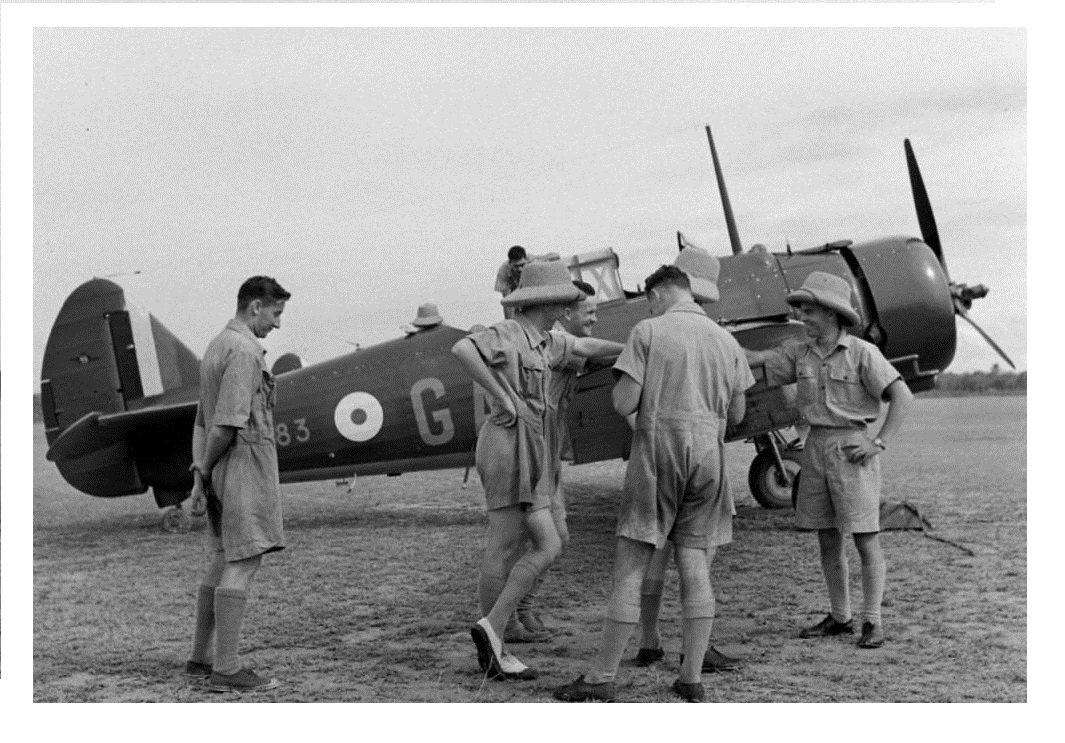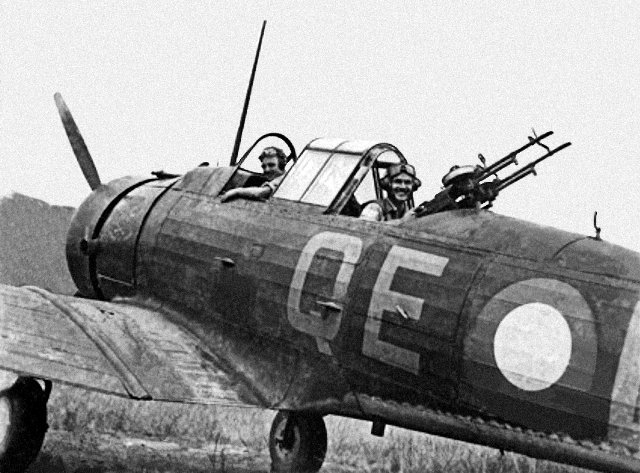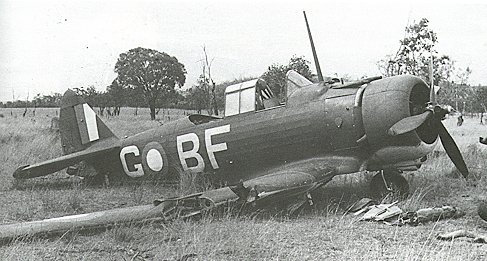The CAC Wirraway (an Aboriginal word meaning "challenge") was a training and general purpose military aircraft manufactured in Australia by the Commonwealth Aircraft Corporation (CAC) between 1939 and 1946. It was an Australian development of the North American NA-16 training aircraft.
The Wirraway has been credited as being the foundation of Australian aircraft manufacturing.

During the Second World War, both Royal Australian Air Force (RAAF) and Royal Australian Navy (RAN) deployed a number of Wirraways into combat roles, where they served in a makeshift light bomber/ground attack capacity, striking against the advancing forces of the Empire of Japan. While the type had been primarily used as a trainer and general purpose aircraft, being present in small quantities within the majority of front-line squadrons for these purposes; the aircraft was often pressed into combat when required.


Typically, fighter versions of the Wirraway were operated over theatres such as New Guinea to perform ground attack missions and other Army co-operation tasks over extended periods until more advanced aircraft had become available in sufficient quantities. On 12 December 1942, the Wirraway achieved its only shoot-down of an enemy aircraft, a Mitsubishi A6M Zero, while flown by Pilot Officer J. S. Archer.
Following the end of the conflict, the Wirraway was operated for over a decade as a trainer by the RAAF, the newly formed RAN Fleet Air Arm, and the squadrons of the Citizen Air Force. During 1957, the last of the RAN's Wirraways was retired, having been replaced by the newer jet-powered de Havilland Vampire; as the CAC Winjeel came into squadron service, the RAAF phasing out its remaining fleet of Wirraways during the late 1950s. Officially, the last military flight to be performed by the type was conduted on 27 April 1959. Notably, the Wirraway had also functioned as the starting point for the design of a wartime "emergency fighter", which was also developed and manufactured by CAC, known as the Boomerang.
The NA-16-2K model was the type selected for initial production. The design featured several detail and structural changes, such as provisions for the fitting of a pair of forward-firing guns instead of the NA-16's single gun, and the strengthening of the tail and wings to better facilitate dive-bombing operations. Other modifications included the adoption of a single gun set on a swivelling mount to the rear of the cockpit, along with the installation of cameras and radio sets.
On 27 March 1939, the first CA-1 Wirraway, RAAF serial A20-3, performed its maiden flight. This aircraft was subsequently retained by CAC for evaluation and trials for a number of months; on 10 July 1939, the first pair of Wirraways to be delivered to the RAAF, serials A20-4 and A20-5, were received by the service.
By the outbreak of the Second World War, the RAAF had received a total of six Wirraways. Early on, it became clear that CAC's rate of manufacture of the airframes outstripped Australian capacity to produce the Wasp engines to power the type. During 1940, having observed an excess of Australian capacity, Britain issued an offer to procure any Wirraway airframes that could be produced that had not already been allocated to fulfil RAAF orders, intending to fit US-built Wasp engines to power them.


This led to the placing of an initial British order for 245 aircraft, the last of which was to be delivered before the end of 1942. During October 1940, this order was expanded to cover 500 aircraft, 300 of which being scheduled for delivery during 1943. While these orders were ultimately unmet due to the implementation of the extensive American-led Lend-Lease arrangement, the British government did finance the procurement of aircraft for Australian use within the Empire Air Training Scheme.
Forty CA-1 Wirraways were constructed before the improved CA-3 variant entered production. Although there were detail changes to the design, the change in designation had more to do with the next batch of Wirraways being built to a different government contract than any real difference between the two sub-types. During February 1942, the Australian War Cabinet issued its approval for the production of 105 Wirraway interceptors as "reinsurance against [an] inability to obtain fighter aircraft from overseas".
Around this time, the War Cabinet also decided to reject an order for 245 Wirraways that had been received from Britain. In July 1940, at which point the United Kingdom was the sole European nation fighting against German in the war, the Australian Government issued a statement advising that "from this date onward Australia can rely on England for no further supplies of any aircraft materials or equipment of any kind.
The CA-5, CA-7, CA-8 and CA-9 models were all broadly similar to the CA-3; only the CA-16 variant featured substantial design changes; amongst other purposes, several wing modifications had been made to allow for the carriage of a heavier bomb load, along with the addition of dive brakes for dive-bombing. Sets of 'dive bomber' wings (as fitted to the CA-16) were built under the designation of CA-10A (the CA-10 model was a proposed dive-bomber variant that remained unbuilt), and retrofitted to CA-3s, −5s, −7s and −9s; 113 Wirraways were converted.


Seventeen Wirraways were modified post-war and delivered to the Royal Australian Navy (RAN), the modifications were incorporated under the CAC designation CA-20. These 17 aircraft included a CA-1, a CA-5 and numbers of all subsequent variants; they were operated under their original RAAF serials. Production of the type continued even after the end of the Second World War. In July 1946, CA-16 A20-757, the last aircraft to be built of a total of 755 Wirraways, was delivered to the RAAF.
----
The CAC Wirraway was a training and general purpose military aircraft. The fuselage comprised a welded framework composed of chrome and steel, which was construction from four separately produced sections bolted together during final assembly. The sides of the fuselage featured fabric covering supported by aluminium alloy frames, while the underside and decking has metal coverings instead. The single-spar wings, which were built in five individual sections, were composed of spaced ribs and a stressed skin.
The control surfaces were metal-framed with fabric covering; the split-flap arrangement of early Wirraways were supplemented on later-built aircraft via the addition of dive brakes. An all-metal stressed skin construction was used for the tailplane and fin; both side of the tailplane were interchangeable.
The Wirraway was powered by a single 600 hp Pratt & Whitney R-1340 Wasp radial engine, licence-built by CAC. the engine drove a three-bladed variable-pitch propeller developed by de Havilland Propellers. Fuel was stored within a pair of 45 gallon tanks. The two-man crew sat within a tandem cockpit, complete with a fully enclosed sliding canopy; both positions were fitted with flying controls. In addition, the rear cockpit featured a rotatable folding seat for the gunner/bomb-aimer, as well as a prone bombing position in the floor of the aircraft.
The Wirraway could carry a light armament of a single 500 lb bomb or a pair of 250 lb bombs under the wings; light bombs or flares could also be carried underneath the centerline section. Additionally, a pair of forward-firing Vickers Mk.V machine guns were fitted along with a single swivel-mounted machine gun positioned at the rear of the cockpit
----
In June 1939, in light of the declining situation in Europe and the increasing likelihood of a major conflict, the Chief of the Air staff recommended the expansion of the RAAF to a total of 32 squadrons; of these, preparations for 9 general purpose squadrons, which were intended to be equipped with the Wirraway, were immediately put into motion.
On 25 August 1939, one month after the first deliveries of the Wirraway had occurred, an official State of Emergency was declared; on 3 September 1939, as the Second World War broke out in Europe, Australia decided to mobilise the entirety of its air force, placing all squadrons on short call for combat operations. However, during the first year of the war, the Wirraway was still being introduced in quantity within many squadrons; this effort was delayed by a temporary shortage of available spare parts.




As its American "cousin" the T-6 (both types having been derived from the NA-16) did for many Allied Air Forces during the Second World War, the Wirraway served as one of the RAAF's main trainer types from 1939. Beside serving as a trainer aircraft they were also operated in combat roles, including as an emergency fighter. At the outbreak of the Pacific War in December 1941 Wirraways equipped seven RAAF squadrons: Nos 4, 5, 12, 22, 23, 24 and 25. A group of five Wirraways based at Kluang in Malaya for training purposes was pressed into combat against Japanese ground invasion forces; these were generally flown by New Zealanders with Australian observers, and had some successes.
As early as 1941, reports on the capabilities of Japanese fighter aircraft fuelled the perception that the Wirraway would be incapable of effectively engaging such aircraft; however, the type was judged to possess some merits in combat despite being considered to be obsolete. Regardless, the type was often put into action against the advancing Japanese forces.

On 6 January 1942, Wirraways of No. 24 Squadron attempted to intercept Japanese seaplanes flying over New Britain; only one managed to engage an enemy aircraft, marking the first air-to-air combat between RAAF and Japanese forces. Two weeks later, eight 24 Squadron Wirraways defended the city of Rabaul from over 100 Japanese attacking bombers and fighters, resulting in the destruction or severe damage of all but two of the Australian aircraft.
On 12 December 1942, Pilot Officer J. S. Archer shot down a Japanese A6M Zero fighter aircraft after having spotted it around 1000 feet (about 300 metres) below him and dived on it, opening fire and sending the Zero hurtling into the sea. This was the only occasion that a Wirraway shot down another aircraft (and is one more than the total of aircraft shot down by its fighter offspring, the Boomerang).
In response to a request by Sir Thomas Blamey for an army cooperation squadron operating a relatively slow aircraft, No. 4 Squadron, equipped with the Wirraway, was dispatched to Port Moresby during early November 1942. Operating over New Guinea, the type performed aerial reconnaissance, photography, artillery spotting, communication, supply drops, dive-bombing, ground attack and propaganda drops. In this capacity, the Wirraway proved to be fairly suitable; however, due to the risk of being misidentified as a hostile Zero, altitude restrictions were often imposed to deter incidents of friendly fire from Allied anti-aircraft gunners.
Having become known for its versatility, fighter versions of the Wirraway operated over New Guinea for some time on ground attack and other Army co-operation tasks until other RAAF aircraft such as the Boomerang and American Curtiss P-40s were made available in sufficient quantity to replace them.
By mid-1943, nearly all frontline use of the Wirraway had come to an end, having been replaced by the newer Boomerang, itself a fighter-orientated derivative of the Wirraway. The majority of front-line squadrons of the RAAF had at least one Wirraway attached to serve as a squadron 'hack', that is, an aircraft employed on errands such as visits to headquarters or other bases. At least one aircraft (formerly A20-527) flew as part of Headquarters Flight 5th Air Force in full United States Army Air Forces markings.
Ei kommentteja:
Lähetä kommentti
Kaikenlaiset kommentit ovat tervetulleita.